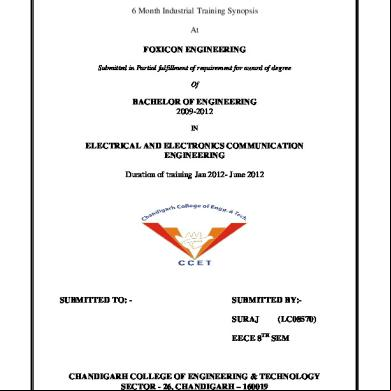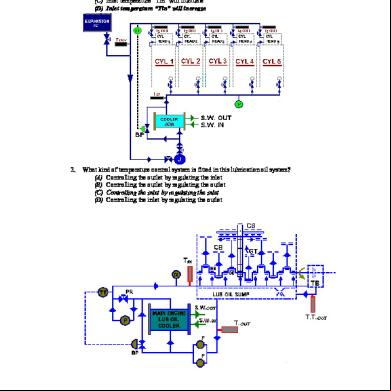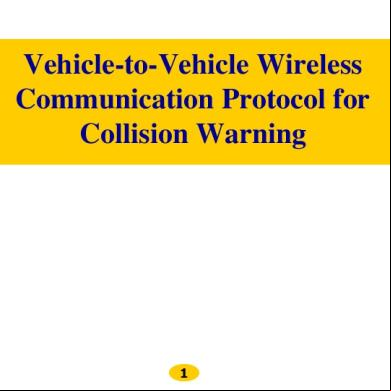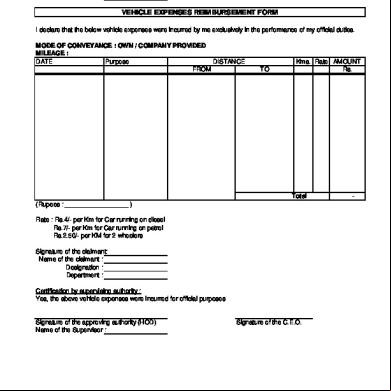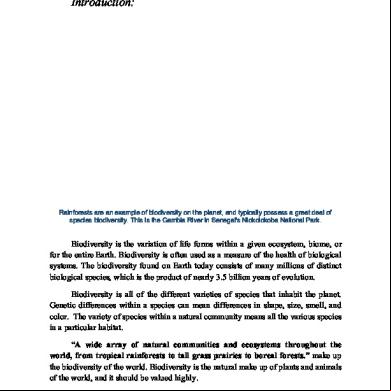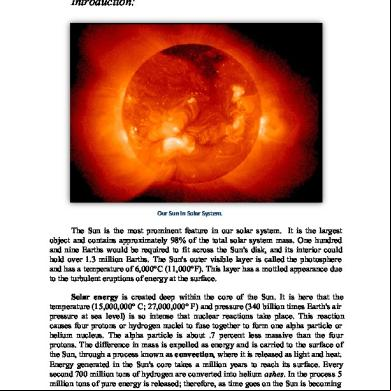Vehicle Automation 2m2x2x
This document was ed by and they confirmed that they have the permission to share it. If you are author or own the copyright of this book, please report to us by using this report form. Report 2z6p3t
Overview 5o1f4z
& View Vehicle Automation as PDF for free.
More details 6z3438
- Words: 1,428
- Pages: 27
Vehicle Tracking Using GPS & GSM Submitted by:
Pranav Bhide (0801CS151055) Burhanuddin Chakkiwala (0801CS151021) Rahul Uikey (0801CS151059) Rupal Awasthi (0801CS151064) Mohanish Mankar (0801CS151044)
Introduction ● We can not keep our eyes on our vehicles all the time . The increasing theft has caused us to be more alert and conscious about them so a guided GPS system can do the job for us. ● If unfortunately our vehicle got into an accident it take a lot of time for the news to get to our family but with the accident detection monitor an sms can be send almost instantly ● We cannot when to do our vehicle servicing leading to excessive emission of carbon monoxide into the environment but with pollution monitoring we can alert the owner to do servicing
Function ● Locate the vehicle at any given time with the help of GPS navigation. ● Detect the accident and alert the owner by sending message ● Detect the Carbon monoxide content and alert if it reaches above threshold
Arduino (ATmega328) ● Arduino is an Italian company that sells circuit boards with micro controllers on it. They call these circuit boards Arduino. ● In layman’s , an Arduino board takes input in the form of signals, processes them, and gives an output. ● Different Arduino contains varying amounts of flash memory, pins and features. ● Arduino provides official IDE to programs on an Arduino board.
Arduino (contd.)
Pin Structure ● The Arduino Uno contains 6 Analog IO pins and 14 Digital IO pins. ● Out of those 14 Digital pins, 6 can be used Pulse Width Modulation or PWM. ● Pulse Width Modulation is used to change the intensity of output signal like dimming the intensity of an LED bulb.
Functional block diagram
Main Circuit Diagram
Carbon Monoxide sensor (MQ7) ● The allowed emission value of CO gas according to Bharat Stage Emission Standard is 6 ppm. ● Hence, our system is set to sound the buzzer if the emission from vehicle goes above 6 ppm. ● The sensor’s output is analog resistance.
Tilt Sensor ● A sensor is a device that responds to some type of the input from the environment such as ● heat, light, motion, temperature, pressure and moisture. ● Every sensor has three terminals: Vcc, GND and output. Vcc is used to power up the sensor and ground is used to provide a fixed negative reference. ● The output of the sensor is analog ● A tilt sensor is an instrument that is used for measuring the tilt in multiple axes of a reference plane. Tilt sensors measure the tilting position with reference to gravity and are used in numerous applications.
Working The tilt sensor functions like a liquid potentiometer. The electrically conductive fluid creates a variable resistance between the electrodes. When the sensor is in the null or balanced position, the resistances between the centre electrode to each outside electrode are equal. Tilting the sensor from its balanced position changes the two resistances producing an electrical output proportional to the tilted angle Figure shows one axis of a fluid-filled sensor tipped at ~15°. As the sensor tilts, the surface of the fluid remains level due to gravity. The fluid is electrically conductive, and the conductivity between the two electrodes is proportional to the length of electrode immersed in the fluid. At the angle shown, for example, the conductivity between pins a and b would be greater than that between b and c. Electrically, the sensor is similar to a potentiometer, with resistance changing in proportion to tilt angle
The electrolytic tilt sensor(level) can be energized in a number of ways depending on the applications and performance required. Typically, there are two ways to energize and read the level. One way to energize the level is the use of a bridge type circuit as shown in figure 3. This configuration allows for the adjustment of the bridge resistors to match the internal impedance of the level. It must be noted that the electrolyte's impedance will change with temperature. The impedance is inversely proportional to temperature. This can cause readings to change with temperature when the level is in an unbalanced position. Therefore, temperature compensation is required in an uncontrolled
environment.
Benefits and application The key benefits of tilt sensors include: ●
Compact and simple to use
●
High resolution and accuracy
●
Very cost-effective
●
Low power consumption
Application
●
To monitor the angle at which a mobile phone or tablet is held for the auto-rotate function
●
To detect the position of hand-held game systems and in game controllers
To indicate the roll of boats, vehicles and aircraft
GPS(Global positioning system) ● GPS is a space-based satellite navigation system. It provides location and time information in all weather conditions, anywhere on or near the Earth. ● GPS receivers are popularly used for navigation, positioning.
● The GPS consists of 24 satellites that orbit around the earth in 6 different orbit as shown in fig.1-1 These satellites are geosynchronous with an orbital period that is the same as the Earth’s rotation period. ● They maintain exactly the same position with respect to the earth below them.
How it works? ● National Marine Electronics Association (NMEA), is a standard data format ed by all GPS manufacturers, much like ASCII is the standard for digital computer characters in the computer world. ● All the GPS satellites transmit radio signals, which are then captured by a GPS receiver and used to calculate its geographical position.
Why we use GPS ? To find the location of the vehicle by using latitude and longitude data.
Features of the GPS : ● 24 satellites in 6 different orbits. ● For a 2D location, 3 GPS satellites are used. ● For a 3D location more than 3 satellites are used.
● A minimum of three satellites are required to compute the latitude and longitude. ● GPS receiver converts the received signals into position and estimates time and some other useful information depending on the application and requirements.
GSM(Global System for Mobile)
● A GSM modem is a specialized type of modem which accepts a SIM card, and operates over a subscription to a mobile operator, just like mobile phone. ● It uses a process called circuit switching. ● GSM method of communication allows a path to be established between two devices, Once the two devices are connected , a constant stream of digital data is relayed.
SIM800A GSM Modem
● The SIM800A modem has a SIM800 A GSM chip and RS232 interface while enables easy connection with the computer or laptop using the USB to serial connector or to the microcontroller using the RS232 to TTL converter. ● The SIM800A - GSM/GPRS is a quad-band that works on frequencies GSM 850MHz ,EGSM 900 MHz, DCS 1800MHz and PCS 1900 MHz . ● It is designed for the global market .
GSM Modem - RS232 - SIM800A
SIM800A Specifications ● Quad band GSM module. ● Voltage Supply Required : 9V dc to 12 Vdc with atleast 2A Peak Current Capability. ● Switching Regulator Based Power Supply ● TTL Rx and TTL Tx and DB9 Based Rs232 Outputs. ● External finger type antenna.
SIM800A Features ● ● ● ● ● ●
Typical power consumption in SLEEP mode is 1 mA. Dimensions 23x23x3 mm. Operating Temperature : -40 to 85 C. T/IP AT firmware. One SIM card interface . Audio channels which include a microphone input and receiver output.
Operating Mode : SMS text mode and SMS PDUmode The SMS specification has defined two modes in which a GSM/GPRS modem or mobile phone can operate. They are called SMS text mode and SMS PDU mode. (PDU stands for Protocol Data Unit.) The mode that a GSM/GPRS modem or mobile phone is operating in determines the syntax of some SMS AT commands and the format of the responses returned after execution.
Below are the SMS AT commands affected:
● +CMGS (Send Message) ● +CMSS (Send Message from Storage)
● +CMGR (Read Message) ● +CMGL (List Messages)
● +CMGC (Send Command)
Syntax of SMS AT Commands and Responses When the GSM/GPRS modem or mobile phone is operating in different modes, the syntax of certain SMS AT commands and the responses returned after command execution is different. Here's an example for illustration. Let's say you would like to send the SMS message "It is easy to send text messages." to the mobile phone number +919424xxxxxx. In SMS text mode, this is the command line that you should enter:
AT+CMGS="+919424xxxxxx"
It is easy to send text
messages.
Pranav Bhide (0801CS151055) Burhanuddin Chakkiwala (0801CS151021) Rahul Uikey (0801CS151059) Rupal Awasthi (0801CS151064) Mohanish Mankar (0801CS151044)
Introduction ● We can not keep our eyes on our vehicles all the time . The increasing theft has caused us to be more alert and conscious about them so a guided GPS system can do the job for us. ● If unfortunately our vehicle got into an accident it take a lot of time for the news to get to our family but with the accident detection monitor an sms can be send almost instantly ● We cannot when to do our vehicle servicing leading to excessive emission of carbon monoxide into the environment but with pollution monitoring we can alert the owner to do servicing
Function ● Locate the vehicle at any given time with the help of GPS navigation. ● Detect the accident and alert the owner by sending message ● Detect the Carbon monoxide content and alert if it reaches above threshold
Arduino (ATmega328) ● Arduino is an Italian company that sells circuit boards with micro controllers on it. They call these circuit boards Arduino. ● In layman’s , an Arduino board takes input in the form of signals, processes them, and gives an output. ● Different Arduino contains varying amounts of flash memory, pins and features. ● Arduino provides official IDE to programs on an Arduino board.
Arduino (contd.)
Pin Structure ● The Arduino Uno contains 6 Analog IO pins and 14 Digital IO pins. ● Out of those 14 Digital pins, 6 can be used Pulse Width Modulation or PWM. ● Pulse Width Modulation is used to change the intensity of output signal like dimming the intensity of an LED bulb.
Functional block diagram
Main Circuit Diagram
Carbon Monoxide sensor (MQ7) ● The allowed emission value of CO gas according to Bharat Stage Emission Standard is 6 ppm. ● Hence, our system is set to sound the buzzer if the emission from vehicle goes above 6 ppm. ● The sensor’s output is analog resistance.
Tilt Sensor ● A sensor is a device that responds to some type of the input from the environment such as ● heat, light, motion, temperature, pressure and moisture. ● Every sensor has three terminals: Vcc, GND and output. Vcc is used to power up the sensor and ground is used to provide a fixed negative reference. ● The output of the sensor is analog ● A tilt sensor is an instrument that is used for measuring the tilt in multiple axes of a reference plane. Tilt sensors measure the tilting position with reference to gravity and are used in numerous applications.
Working The tilt sensor functions like a liquid potentiometer. The electrically conductive fluid creates a variable resistance between the electrodes. When the sensor is in the null or balanced position, the resistances between the centre electrode to each outside electrode are equal. Tilting the sensor from its balanced position changes the two resistances producing an electrical output proportional to the tilted angle Figure shows one axis of a fluid-filled sensor tipped at ~15°. As the sensor tilts, the surface of the fluid remains level due to gravity. The fluid is electrically conductive, and the conductivity between the two electrodes is proportional to the length of electrode immersed in the fluid. At the angle shown, for example, the conductivity between pins a and b would be greater than that between b and c. Electrically, the sensor is similar to a potentiometer, with resistance changing in proportion to tilt angle
The electrolytic tilt sensor(level) can be energized in a number of ways depending on the applications and performance required. Typically, there are two ways to energize and read the level. One way to energize the level is the use of a bridge type circuit as shown in figure 3. This configuration allows for the adjustment of the bridge resistors to match the internal impedance of the level. It must be noted that the electrolyte's impedance will change with temperature. The impedance is inversely proportional to temperature. This can cause readings to change with temperature when the level is in an unbalanced position. Therefore, temperature compensation is required in an uncontrolled
environment.
Benefits and application The key benefits of tilt sensors include: ●
Compact and simple to use
●
High resolution and accuracy
●
Very cost-effective
●
Low power consumption
Application
●
To monitor the angle at which a mobile phone or tablet is held for the auto-rotate function
●
To detect the position of hand-held game systems and in game controllers
To indicate the roll of boats, vehicles and aircraft
GPS(Global positioning system) ● GPS is a space-based satellite navigation system. It provides location and time information in all weather conditions, anywhere on or near the Earth. ● GPS receivers are popularly used for navigation, positioning.
● The GPS consists of 24 satellites that orbit around the earth in 6 different orbit as shown in fig.1-1 These satellites are geosynchronous with an orbital period that is the same as the Earth’s rotation period. ● They maintain exactly the same position with respect to the earth below them.
How it works? ● National Marine Electronics Association (NMEA), is a standard data format ed by all GPS manufacturers, much like ASCII is the standard for digital computer characters in the computer world. ● All the GPS satellites transmit radio signals, which are then captured by a GPS receiver and used to calculate its geographical position.
Why we use GPS ? To find the location of the vehicle by using latitude and longitude data.
Features of the GPS : ● 24 satellites in 6 different orbits. ● For a 2D location, 3 GPS satellites are used. ● For a 3D location more than 3 satellites are used.
● A minimum of three satellites are required to compute the latitude and longitude. ● GPS receiver converts the received signals into position and estimates time and some other useful information depending on the application and requirements.
GSM(Global System for Mobile)
● A GSM modem is a specialized type of modem which accepts a SIM card, and operates over a subscription to a mobile operator, just like mobile phone. ● It uses a process called circuit switching. ● GSM method of communication allows a path to be established between two devices, Once the two devices are connected , a constant stream of digital data is relayed.
SIM800A GSM Modem
● The SIM800A modem has a SIM800 A GSM chip and RS232 interface while enables easy connection with the computer or laptop using the USB to serial connector or to the microcontroller using the RS232 to TTL converter. ● The SIM800A - GSM/GPRS is a quad-band that works on frequencies GSM 850MHz ,EGSM 900 MHz, DCS 1800MHz and PCS 1900 MHz . ● It is designed for the global market .
GSM Modem - RS232 - SIM800A
SIM800A Specifications ● Quad band GSM module. ● Voltage Supply Required : 9V dc to 12 Vdc with atleast 2A Peak Current Capability. ● Switching Regulator Based Power Supply ● TTL Rx and TTL Tx and DB9 Based Rs232 Outputs. ● External finger type antenna.
SIM800A Features ● ● ● ● ● ●
Typical power consumption in SLEEP mode is 1 mA. Dimensions 23x23x3 mm. Operating Temperature : -40 to 85 C. T/IP AT firmware. One SIM card interface . Audio channels which include a microphone input and receiver output.
Operating Mode : SMS text mode and SMS PDUmode The SMS specification has defined two modes in which a GSM/GPRS modem or mobile phone can operate. They are called SMS text mode and SMS PDU mode. (PDU stands for Protocol Data Unit.) The mode that a GSM/GPRS modem or mobile phone is operating in determines the syntax of some SMS AT commands and the format of the responses returned after execution.
Below are the SMS AT commands affected:
● +CMGS (Send Message) ● +CMSS (Send Message from Storage)
● +CMGR (Read Message) ● +CMGL (List Messages)
● +CMGC (Send Command)
Syntax of SMS AT Commands and Responses When the GSM/GPRS modem or mobile phone is operating in different modes, the syntax of certain SMS AT commands and the responses returned after command execution is different. Here's an example for illustration. Let's say you would like to send the SMS message "It is easy to send text messages." to the mobile phone number +919424xxxxxx. In SMS text mode, this is the command line that you should enter:
AT+CMGS="+919424xxxxxx"
messages.

